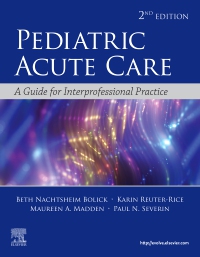
Pediatric Acute Care, 2nd Edition
Elsevier eBook on VitalSource

Ensure that your students are up-to-date on the latest evidence and clinical practice in pediatric acute care with the definitive textbook in the field. Now in its second edition, Pediatric Acute Care: A Guide for Interprofessional Practice takes an evidence-based, interprofessional approach to pediatric acute care as it exemplifies the depth and diversity that’s needed for the dynamic healthcare environments in which acutely ill children receive care. With contributions from more than 200 practicing clinicians and academic experts, it represents a wide variety of disciplines and is an ideal text for students as well as practicing nurse practitioners, physician assistants, physicians, and other pediatric healthcare professionals. Coverage includes how to work with the pediatric patient and family, major acute care disorders and their management, emergency preparedness, common acute care procedures, and much more. The second edition also features the addition of new physician and nurse practitioner co-editors as well as extensive content updates including updated evidence-based content throughout, the integration of the 2016 IPEC Core Competencies for Interprofessional Collaborative Practice, a new full-color design, new full-color illustrations, and new online instructor resources.
-
- NEW! Updated evidence-based content has been added throughout to ensure that students are up-to-date on all topics needed to provide care for pediatric patients in acute, inpatient, emergency, transport, and critical care settings.
- NEW! Full-color design and illustrations enhance learning and make content easier to navigate and digest.
- NEW! Integration of the 2016 IPEC Core Competencies ensures that students are learning the professional skills and protocols required for effective, contemporary interprofessional collaborative practice.
- UPDATED! Streamlined procedures unit focuses more sharply on need-to-know content to make the most of limited study time.
- UNIQUE! Interprofessional collaborative approach includes contributions from more than 200 practicing clinicians and academic experts from the U.S. and Canada, including nursing, medicine, pharmacy, child life, nutrition, law, integrative medicine, education, public health, and psychology.
- Consistent organization within disorder chapters begins with a section on Physiology and continues with sections on Pathophysiology, Epidemiology and Etiology, Presentation, Differential Diagnosis, Diagnostic Studies, and a Plan of Care that includes Therapeutic Management, Consultation, Patient and Family Education, and Disposition and Discharge Planning.
- Comprehensive content divides coverage into introductory information, the approach to the pediatric patient and family, major acute care disorders and their management, emergency preparedness, and common acute care procedures.
- UNIQUE! Coverage of simulation and assessment is addressed in each chapter wherever key educational issues are discussed.
- Educator Evolve Resources feature eleven clinical simulation scenarios, sixteen case studies, and an image collection.
-
- NEW! Updated evidence-based content has been added throughout to ensure that you’re up-to-date on all topics needed to provide care for pediatric patients in acute, inpatient, emergency, transport, and critical care settings
- NEW! Full-color design and illustrations enhance learning and make content easier to navigate and digest
- NEW! Integration of the 2016 IPEC Core Competencies ensure that you’re learning the professional skills and protocols required for effective, contemporary interprofessional collaborative practice
- UPDATED! Streamlined procedures unit focuses more sharply on need-to-know content
-
Part I. Interprofessional Patient Care
1. The Interprofessional Team
2. Research and Evidence-Based Practice
3. Certification, Licensure, and Credentialing/Privileging
4. Documentation and Coding
5. Team Communication and Handoffs
6. Patient Safety
Part II. Approach to the Pediatric Patient and Family
7. Child Life: Developmental Considerations
8. Patient and Family-Centered Care
9. Communicating Bad News
10. Ethical Considerations
11. Care of the Minor and Legal Implications
12. Transition to Adulthood
13. Care of Children with Medical Complexity
14. Management in the Emergency Setting
15. Management in the Inpatient Setting
16. The Premature Infant in the Pediatric Acute Care Setting
17. Management of the Chronically Critically Ill
18. Transport of the Ill or Injured Pediatric Patient
19. Rehabilitation
20. Palliative Care and Integrative Medicine
Part III. Selected Disorders and Their Management
21. Analgesia, Paralytics, Sedation, Withdrawal, and Opioid Disorders
22. Cardiac Disorders
23. Dermatologic Disorders
24. Endocrine Disorders
25. Fluid, Electrolytes, and Nutrition
26. Gastrointestinal Disorders
27. Genetic and Metabolic Disorders
28. Hematologic and Oncologic Disorders
29. Immunologic/Autoimmune and Rheumatologic Disorders
30. Infectious Disorders
31. Kidney and Genitourinary Disorders
32. Musculoskeletal Disorders
33. Neurologic Disorders
34. Orofacial Disorders
35. Pulmonary Disorders
36. Child Maltreatment
37. Toxicologic Exposures
38. Traumatic Injuries
Part IV. Emergency Preparedness
39. Principles of Disaster Management and Clinical Practice
Part V. Procedures
40. Arterial Catheter Insertion
41. Central Venous Catheter Insertion and Removal
42. Chest Tube Insertion and Removal
43. Intracardiac Line Removal
44. Intraventricular Catheter Insertion and Shunt Access
45. Lumbar Puncture
46. Postpyloric Feeding Tube Insertion
47. Peripherally Inserted Central Venous Catheter (PICC) Insertion and Removal
48. Peritoneal Catheter Insertion
49. Rapid-Sequence Intubation
50. Ultrasound Guidance
51. Wound Closure
Part VI. Lab Values
52. Laboratory Values
Part VII. Learning and Evaluation
53. Simulation
54. The Role of Assessment in Teaching and Learning


 as described in our
as described in our 